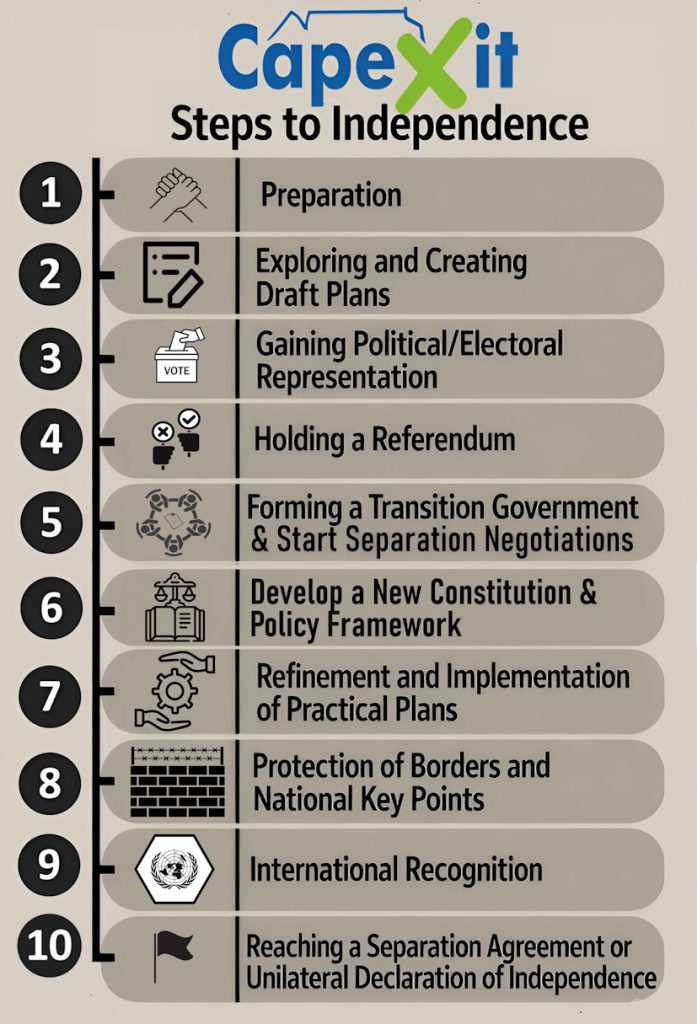Independence is not a dream—it’s a process. For the Western Cape, the journey to independence follows a clear, achievable roadmap grounded in democracy, good governance, and the will of the people. Every nation that has successfully established its sovereignty—whether Kosovo or South Sudan—has done so through persistence, planning, and above all, public support.
The CapeXit movement has refined this roadmap into 10 practical steps that guide how the Western Cape can move from preparation to full independence. Each step builds on the one before, but all rely on a single, irreplaceable foundation: the participation of the people.

Step 1: Preparation
Every movement begins with awareness. Preparation means educating citizens about their democratic rights under international law, building alliances with local and global partners, and growing a strong base of support. It’s about giving people the knowledge and confidence to believe that independence is both possible and necessary. Without public understanding and commitment, no movement can gain traction.
Step 2: Exploring and Creating Draft Plans
While support grows, practical groundwork must begin. Expert working groups and advisors can prepare white papers on key issues such as border security, currency, taxation, trade, and governance. However, these plans must be open, transparent, and shaped with public input—ensuring that citizens remain active participants in designing the Cape’s future. Transparency and inclusivity in this process not only build trust but also strengthen the legitimacy of every decision taken. These plans demonstrate seriousness and reassure citizens and international partners that the future Cape Republic will be well-run and stable from day one.
Step 3: Gaining Political and Electoral Representation
To advance the cause, pro-independence voices must gain representation in municipal and provincial structures. This allows the movement to influence policy, propose bills, and advocate for self-determination from within. The greater the electoral footprint, the stronger the democratic legitimacy of the independence agenda.
Step 4: Holding a Referendum
The heart of any independence process is the people’s vote. A referendum is the purest expression of democracy—allowing every voter in the Western Cape to decide their own future. Whether organized privately or publicly, a fair and transparent referendum provides the essential mandate for independence and proves to the world that this is the will of the people, not of politicians.
Step 5: Forming a Transition Government and Starting Separation Negotiations
Once a clear mandate is secured, a transition council or representative assembly can begin formal discussions with the South African government. The focus is on cooperation and peaceful separation, ensuring that the Cape’s independence benefits both sides. International observers, including the African Union and the United Nations, can play a key role in ensuring transparency.
Step 6: Developing a New Constitution and Policy Framework
An independent Cape Republic must be founded on sound democratic principles—liberty, equality, merit, and non-racialism. A new constitution will enshrine these values, guaranteeing rights and freedoms for all citizens. Policy frameworks will shape future governance, ensuring that the state serves its people efficiently and fairly.
Step 7: Refinement and Implementation of Practical Plans
With independence negotiations underway, earlier draft plans are refined into operational programs. Institutions for tax collection, energy supply, social services, and national administration must begin to function under Cape management. The transition from national to provincial control is gradual but crucial to ensure continuity and stability.
Step 8: Protection of Borders and National Key Points
A sovereign state must control its borders and secure its vital infrastructure. This step involves establishing a Cape Defence Force, customs services, and border management systems to ensure safety, economic security, and regulated migration. Protecting critical assets such as ports, power stations, and communication hubs guarantees that the Cape’s independence is not only symbolic but practical.
Step 9: International Recognition
Recognition by other nations and international bodies formalizes statehood. A strong public mandate makes this step possible—countries and organizations like the UN or the EU recognize new states that clearly express their people’s will through democratic means. International recognition opens the door to trade, cooperation, and prosperity.
Step 10: Reaching a Separation Agreement or Declaring Independence
The final step is the formal act of separation—either through a negotiated treaty with South Africa or, if necessary, a Unilateral Declaration of Independence (UDI) supported by the people’s vote. This is the culmination of years of effort and preparation, marking the birth of a new, self-determined nation.
The Power of Public Participation
Each of these ten steps depends on one thing: YOU.
Every signature, vote, and conversation strengthens the legitimacy of the Cape’s right to self-determination. International recognition does not begin in the halls of the UN—it begins in the hearts and homes of ordinary citizens. The world takes notice when a people stand united behind their cause, peacefully and democratically.
Public participation is not only a duty—it is the most powerful tool we have. The path to independence is long, but with unity and purpose, the people of the Western Cape can make history. The journey begins with belief, continues through action, and ends with freedom.
Dr. Joan Swart has a PsyD Forensic Psychology, an MBA and a Masters in Military Studies. She is a director of CapeXit NPO.

